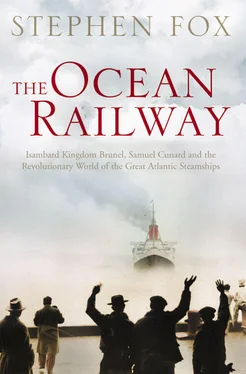After the Glasgow’s pioneering voyage from the Clyde to the Thames, Napier set out to build a steamboat designed for regular ocean service. He studied the sailing packets that took up to a week to run from Glasgow to Belfast, the shapes of their bows and how they moved through the high swells of the Irish Sea. Under sail, the masts acted like tall levers, pushing down the forward part of the hull and demanding extra buoyancy there. Did steam propulsion therefore call for a different kind of hull? Napier tried various models in a tank of water. Eventually he decided to slice the full, rounded bow of the sailing packets into a sharper, finer wedge shape for his steamboats. The Rob Roy, the first vessel so designed, was built by his kinsman William Denny of Dumbarton in 1818. She was eighty feet long and eighty-eight tons, with a thirty-horsepower engine by Napier. Under Napier’s own command – he would try his hand at anything – she ran from Dublin to Greenock in an unprecedented twenty-six hours. For two years the Rob Roy gave reliable service between Greenock and Belfast, then was transferred to the English Channel to run between Dover and Calais.
Over the next few years Napier built progressively larger vessels, up to the 240-ton, 70-horsepower Superb and the 350-ton, 100-horsepower Majestic, for other packet lines to Dublin and Liverpool. These ocean steamers were bigger, stronger, and more powerful than anything else yet built in Great Britain. Their success meant that steamboats were starting to evolve into steamships – though still, for the time being, with the old masts and sails and wooden hulls. ‘ I was the firstthat successfully established steam packets in the open sea,’ Napier claimed in 1822, when obliged to brag by competing claims on behalf of Boulton and Watt. ‘The Superb is now plying the third year between Greenock and Liverpool, and not a single article of her machinery has ever given way, although she has been out in the worst of weather… The truth is, I have made nearly double the number of engines for boats going to sea that Mr. Watt has, and their machinery has not in a single instance been so far deranged as to prevent them from making their passage in a reasonable time.’
As engineer, shipowner, packet entrepreneur and sometime ship captain, Napier was forever popping with ideas and inventions. He pushed the evolving steamship forms to their limits, skirting and sometimes exceeding those vague boundaries at which novelty became dangerous. For all his mechanical brilliance, he lacked a sense of due restraint and proportion. He charged ahead like a dashing cavalry regiment, leaving to humbler foot soldiers the grubby tasks of mopping up and administering details. In time he yielded the leadership of Clyde steamship engineering to his cousin Robert, who was less inventive and dazzling but more patient and meticulous and, ultimately, more sound and substantial.
Robert Napierwas born in Dumbarton in 1791 with, as he liked to say, a hammer in his hand, the son and grandson of blacksmiths. Of Robert and his three brothers, one became a minister while the others followed family tradition into smithing and millwrighting. At the Dumbarton grammar school, Robert received a liberal education, supplemented by outside lessons in mechanical drawing which gave him a lifelong taste for fine paintings and beautiful objects. His father groomed him for college, but Robert preferred to apprentice in the family workshop. He excelled at ornamental ironwork, fashioning metal into art. In his spare time he made tools and guns, and practised drawing. At twenty he took off for Edinburgh, armed with an allowance of five pounds from his father and a certificate of good character from the minister of his parish. Soon he was back to work briefly for his father and then left home for good, this time to Glasgow. His artistic side may have craved the heady intellectual ferment of Edinburgh and the Scottish Enlightenment, but he was an engineer at heart, at home on the Clyde.
Bankrolled by fifty pounds from his father, in 1815 he bought the tools and goodwill of a small blacksmith shop. By making millwheels and tools for tinsmiths, he prospered enough to marry his first cousin Isabella Napier three years later. The marriage brought him into closer contact with her brother, cousin David. Restless as ever, in 1821 David let Robert take over his business at Camlachie Foundry, at the east end of the Gallowgate. Robert made iron pipes for the Glasgow Water Company, which had just started pumping from the Clyde, and then his first steam engine, for a spinning factory in Dundee.
In 1823, thirty-two years old, Robert Napier found his métier by making his first marine engine. It was installed in the Leven, built by James Lang of Dumbarton for the river traffic between that town and Glasgow. Napier was crucially assisted, with the Leven and for the next four decades, by his recently hired works manager, David Elder, who had come from a family of millwrights near Edinburgh. For the Leven’s engine, Elder made various refinements in the air pump, condenser and slide valves. He was using the rudimentary machine tools of the day, which were powered by a central steam engine linked to overhead belts and pulleys. At Camlachie Foundry these devices ran just a few turning lathes (the small pulleys and belts were forever slipping), a horizontal boring mill, and a smaller vertical boring machine. From these modest beginnings, Elder gradually improved his tools, products and men. The veteran millwrights of the time would not work to the tolerances he demanded, so he preferred to hire cartwrights and house carpenters instead, transferring their fine woodworking skills to the new problems of metal fabrication. ‘ He was a manof great natural force of character,’ it was said of David Elder, ‘and maintained his opinions with considerable vigour.’
The Leven’s steadfast performance brought the firm other marine contracts. For the United Kingdom of 1826 – the biggest, fastest British steam vessel yet at 175 feet and 560 tons – they put an engine of 200 horsepower in the ship built by Robert Steele of Greenock. In 1828 they moved to a larger site in Glasgow, the soon-famous Vulcan Foundry on Washington Street, near the river. They added heavy new machine tools for making even more powerful engines. Robert Napier and David Elder became, by general reputation, the best engineers on the Clyde.
Any new steam-powered shipping company would routinely seek Napier’s advice and active participation; his approval could mark the difference between success and failure. In the workshop, Elder continued his ongoing technical improvements and trained several generations of the top Clyde engineers, including his distinguished son John. Eventually Napier acquired his own shipbuilding yard as well, at Govan on the south bank of the Clyde, and applied the firm’s exacting standards to every aspect of producing a steamship. One of his most loyal and long-term customers would be Samuel Cunard.
As Henry Bell had insisted about himself, these pioneers of Clyde steamboat building – from William Symington to Robert Napier – were not just self-taught engineers who worked simply by untutored intuition. They typically had mentors and family backgrounds in their fields. But most of their education did take place outside school, and the best of them then engaged in a continuous process of self-education all through their working lives. Immersed in such a bold new undertaking, they had to contrive their own patterns. They ‘ read Nature’s lawsin their own fashion’, the Scottish naval architect Robert Mansel remarked after the younger Robert Steele’s death in 1879. ‘Admittedly they knew little or no Latin or Greek, and, on the whole, were decidedly averse to talking and talkers.’ Diligent and laconic in the Scots manner, they left terse, incomplete surviving records of what they did, and nothing whatever about their private thoughts and feelings. Any curiosity about such intimacies would have puzzled them. They poured themselves into their steamboats and steam engines – which also have not survived, except for a few stray shards. Entering their world now requires an act of imagination, with casual leaps over yawning gaps in the historical evidence.
Читать дальше












